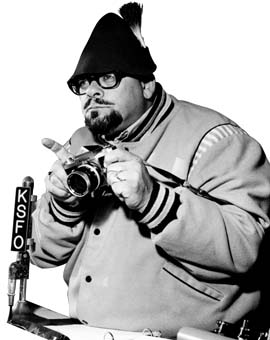 It's late. In the background, a piano plays a drowsy blues.
Then a voice:
It's late. In the background, a piano plays a drowsy blues.
Then a voice:"People ask me what it looks like down in the Grotto, and I haven't really said too much about it lately, I guess, but one of the main things is that in order to get here you've got to come down a long kind of underground tube that leads in from street level. At Forty-second and Third. You crawl in on a tube over which there's a burlap sack hanging down. That's to keep the wind and cold air from blowing in. And then you are immediately in the main cave room, which is hemispherical and looks almost vaulted at the highest point...about twenty feet above the Grotto floor, which is flat and dry. "And the Big Ben stalagtite, which is the largest one of several, comes down fifteen feet from the ceiling. And then there are smaller ones growing up from the floor of the Grotto (and one is about five feet, six feet high) and those are stalagmites. If they ever connect, they're called columns, and we have three of these, where a stalagtite and a stalagmite have...grown together. It's very rare, but we have 'em." The piano shimmers. The voice resumes. "And at the top of the Grotto it's very dark purple, almost black. And then it starts getting progressively light as it goes down the side, [piano] getting into the various shades of purple, mauve, magenta, taupe, and all those. And then if you look over to the left side you will see a mushroom patch growing there of the Purpulus grottus variety, and they're about four feet in diameter. They're huge. And that's where I got the idea to have Purple Grotto-burgers. I was gonna have a series around town underneath the ground where you go in and have a Grotto-burger. 'Cause mushrooms ...are very much like steak (filet mignon)...if you get a good mushroom. And these are the best... "Over on the extreme right there's a pit of fluid that's almost like a small lake. And it's a fluid that has not been analyzed as yet. It's thick, and we've plumbed the depths to about two hundred fifty, three hundred feet with lead weights and wire, and there's no sounding the bottom. So that's one of the reasons no people are allowed down in the Grotto. I just can't get insurance for a place like this..."
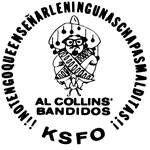 What?
Where are we? For all the sense it's making, it might as well be Mars in
2856, or maybe 7680. But we're in New York City, in 1982. It's four in
the morning; we're tuned to radio station WNEW, and the piano, the
voice, and the way-out word jazz belong to Al "Jazzbo" Collins (or
"Jazzbeaux," depending on how whimsical he feels...)
What?
Where are we? For all the sense it's making, it might as well be Mars in
2856, or maybe 7680. But we're in New York City, in 1982. It's four in
the morning; we're tuned to radio station WNEW, and the piano, the
voice, and the way-out word jazz belong to Al "Jazzbo" Collins (or
"Jazzbeaux," depending on how whimsical he feels...)
Cool may not even be the word for Collins. He's of it, inside it, beyond cool. Just ask the Jazzbo multitudes, Al's Pals (they must number in the hundreds of thousands by now) gathered around radios in San Francisco, Salt Lake, and L.A., where they're waiting for him to return, as if to ask, "Did it really happen?" It did. It does, weeknightly, midnight to 5:30a.m. now in New York, just as it did from 1950 to 1960.
Back then they turned to Jazzbo for jazz. He was in the clubs, at Birdland and the Hickory House, down at the downbeat office, digging, and he was on the air laying a taste on the ears (Dizzy Gillespie, Charlie Parker, Sinatra and Shearing and Peggy Lee, and Slim Gaillard doing that whole "mello-roony" rap about "Ce-ment mixer, putty putty.")
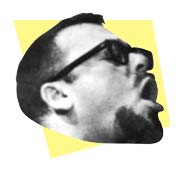 But
if it's music that brought 'em in, it was Jazzbo who kept them coming
back, with an announcing style so laid back it was four winks west of
Sominex, but so hip. Snooze and you lose, 'cause what he's saying at
that crazy half-speed is twice as gone as any other disc jockey you've
ever heard.
But
if it's music that brought 'em in, it was Jazzbo who kept them coming
back, with an announcing style so laid back it was four winks west of
Sominex, but so hip. Snooze and you lose, 'cause what he's saying at
that crazy half-speed is twice as gone as any other disc jockey you've
ever heard.
It all started at the University of Miami in 1941 with the line "What's new at the 'U'? This is Al Collins, and here's Professor Hoo-ha." Subbing for a fellow student, Collins made his radio debut on the college station by accident. No matter. After reading the line, standing for the first time in the studio control room "with the lights, the 'On the air' signals, the engineer, the mike, the drama of the thing hit me with a bursting brilliance. And I said to myself, 'Hey. Whew! What a scene. I think I would like to do this.'"
At Chicago's WIND a few years later, his engineer suggested Collins use something with the word jazz to title his program, which was, after all, a jazz show. A product of the day, a clip-on bow tie called Jazzbows, did the trick. "I went on the air that night," Collins remembers, "and said, 'Hi, this is Jazzbo here with some really fine music.' And the phones started ringing and everybody wanted to know 'Who's Jazzbo?' I said, 'Heck, it's a really good handle.'"
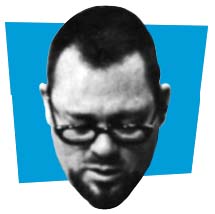 The
handle helped get Collins to WNEW in 1950. He recalls a night there,
too.
The
handle helped get Collins to WNEW in 1950. He recalls a night there,
too.
"I started my broadcast in Studio One which was painted all kinds of tints and shades of purple on huge polycylindricals which were vertically placed around the walls of the room to deflect the sound. It just happened to be that way. And with the turntables and desk and console and the lights turned down low, it had a very cavelike appearance to my imagination. So I got on the air, and the first thing I said was, 'Hi, it's Jazzbo in the Purple Grotto.' You never know where your thoughts are coming from, but the way it came out was that I was in a grotto, in this atmosphere with stalagtites and a lake and no telephones. I was using Nat Cole underneath me with 'Easy Listening Blues' playing piano in the background."
For fun, Collins gave the Grotto its own bestiary - Harrison the Tasmanian Owl, who dug Paul Desmond and Brubeck; Jukes, a female chameleon who went for swing; Clyde, a Dixieland-digging crow; and a flamingo named Leah, who, Jazzbo told his listeners, liked "music to fly by."
The combination hit hip Manhattanites like a saucer from the spheres; within days, fans began showing up at 'NEW demanding to be taken downstairs to the Purple Grotto.
Collins capitalized on his radio fame in 1954, cutting a series of "Great Moments in Hipstery" bop-talk records for Capitol. "Little Red Riding Hood" was his hit, but "Discovery of America" had some choice lines. On Columbus, "hanging out at the royal court in Spain": "Chris has been on the scene for months and there's one thing on his mind: boats. It was then that he met Queen Isabella, who had only one thing on her mind: (ahem). In short, she had bulging eyes for our man. In fact, she was verily flipping her coronet for Mr. C..."
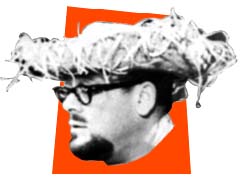 Jazzbo split for San Francisco in 1960 (where he was to
stay until 1969). He kicked things off at KSFO there with the "Collins
on a Cloud" show. To the accompaniment of dreamy harp music, Collins
"floated" over the city, looking down and grooving on the bridges,
ships, and scenes.
Jazzbo split for San Francisco in 1960 (where he was to
stay until 1969). He kicked things off at KSFO there with the "Collins
on a Cloud" show. To the accompaniment of dreamy harp music, Collins
"floated" over the city, looking down and grooving on the bridges,
ships, and scenes.
From '60 to '62 he had his own TV show on the local ABC affiliate, mornings at 8:30 right after the Crusader Rabbit cartoons and before Jack LaLanne's warm-ups. Many viewers (this one included) couldn't quite believe their eyes or ears. Here was Collins, in sky-blue jumpsuits, interviewing celebrities, politicians, sheiks, musicians, and Third Street bums as they sat in a barber chair. Here were impromptu studio performances by the entire Count Basie Band, Louis Prima, Jackie Mason, and others.
"The producer of the show and I would drive down the street in San Francisco. If we saw anybody that looked like a character - or anybody that looked different from everybody else - we'd yell at them, 'Seven o'clock tomorrow morning at Channel Seven. Be there!' We got great guests - one pirate-looking guy with a wooden leg who walked around like Captain Hook."
A central part of the TV program was the (sometimes multiple) screenings(s) of the scene from Treasure of the Sierra Madre where Mexican actor Alfonso Bedoya tells Bogart, "Badges? [pronounced botches] I don't have to show you any stinking badges!" The line has delighted Collins for twenty years. He liked it so much, in fact, that in 1970, while in Los Angeles' KFI, he convinced city fathers in suburban Sierra Madre to help him stage a festival for the faithful. Twenty-five thousand showed up to nosh with their hero, attend art exhibits, and enjoy round-the-clock showings of the movie at the town's Humphry Bogart Theatre.
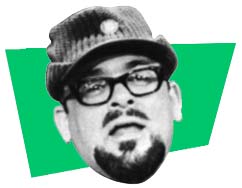 Late
in 1981, Jazzbo left Frisco's KGO to return to 'NEW. Re-ensconced in the
Purple Grotto, he's once again mild and woolly in New York - fading out
a Coleman Hawkins side to deliver an impromptu dissertation on the
virtues of egg-drop soup ("A lot of people misunderstand it. It's best
when it gets into a gelatinous kind of feeling, if you know what I
mean."), plugging a small-press poetry mag, inviting character-callers
like the Baron of Bleecker Street to phone in.
Late
in 1981, Jazzbo left Frisco's KGO to return to 'NEW. Re-ensconced in the
Purple Grotto, he's once again mild and woolly in New York - fading out
a Coleman Hawkins side to deliver an impromptu dissertation on the
virtues of egg-drop soup ("A lot of people misunderstand it. It's best
when it gets into a gelatinous kind of feeling, if you know what I
mean."), plugging a small-press poetry mag, inviting character-callers
like the Baron of Bleecker Street to phone in.
The Baron is the head of Società Mangione ("the society of people who love to eat"), the first New York chapter of Al's Pals, more than three hundred individual special interest clubs formed by Jazzbo buffs across the country.
"That whole thing started in San Francisco," says Al. "We were having a bad drought, and one night this lady called up the show. Her name was Olga, and she talked like Zsa Zsa Gabor. She was off the wall, to put it mildly. She'd go out in the morning in Bodega Bay, where she lived, and greet the tide with a sign that said, 'Welcome In, Tide,' and she'd perfume some of the flowers that had no original scent. She went out with a pitch pipe and gave the hummingbirds the right note so they wouldn't be out of tune. So she called one night and said, 'Jazzbo dahling, if you want to have water, you must have frogs. Everybody knows that where frogs are, there's water, so if everybody gets a pair of frogs and puts them in their back yards, soon we'll have water.'
"So, I said, 'Gee, that's a great idea, Olga.' And I hung up. About ten minutes later a guy named Mike calls and says 'Al, I have an albino frog with pink eyes, and I'd like to be a member of the frog club.' So I said, 'Listen, Mike, if you've got a pink frog with red eyes or whatever, I think you should be the president of the Frogonians.' He agreed. I gave his address, and in a week he had about forty-five letters from people. And today it's still going and he's got over ten thousand registered members."
Jazzbo seems pleased just to keep it all spinning, from behind his pickle barrel in the Grotto. The calibrated candle's white and purple rings tick off the minutes in a slow burn beneath Forty-second and Third. On the turntable something cool from the West Coast spins. The lights dim.
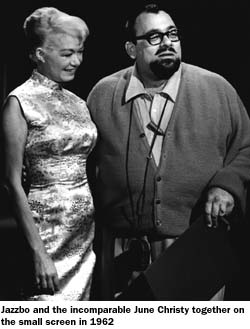 "...And then there are three lesser caves that you
can see in the background if you look straight ahead in the Grotto.
These are occupied by Doctors Hunyati, Cherumbolo, and Caligari. As a
matter of fact, Caligari is up tonight, sanding down some of the small
cabinets he's making. Dr. Hunyati, of course, is the famous piano tuner
who developed that pinkie cream for pianists, and Dr. Victor T.
Cherumbolo you know as the fellow who helps out at the planetarium...and
shows people where the different planets are, 'cause he's from
there."
"...And then there are three lesser caves that you
can see in the background if you look straight ahead in the Grotto.
These are occupied by Doctors Hunyati, Cherumbolo, and Caligari. As a
matter of fact, Caligari is up tonight, sanding down some of the small
cabinets he's making. Dr. Hunyati, of course, is the famous piano tuner
who developed that pinkie cream for pianists, and Dr. Victor T.
Cherumbolo you know as the fellow who helps out at the planetarium...and
shows people where the different planets are, 'cause he's from
there."
POSTSCRIPT: At the end of the '80s, Jazzbo left New York to return to the Bay Area. As if in a dream, California members of the Collins cargo cult-who'd despaired of ever grokking the Grotto again-awoke one morning (May, 1990) to find A.C. on the a.m. (KAPX, Marin County). He was as good as they'd remembered: kibitzing on the phone with anyone who called (to a local chef: "Yeah, I wanna get the recipe to that special meat sauce. Let me find a pencil and we'll take it from the top"), spinning choice sounds ("Man, can we ever have too much Errol Garner?").
By 1993, Jazzbo had moved to KCSM, the jazz station at the College Of San Mateo ('60s comic-prankster Mal Sharpe also does a show there), where he's been ever since: Saturdays, from 9 p.m. to midnight. If you're in Frisco, loose your lobes on him (FM 91).
Gene Sculatti followed the "CATALOG OF THE COOL" with "The Cool And The Crazy" radio series, which he co-hosted and produced with Ronn Spencer, over Santa Monica's (Calif.) KCRW-FM from 1984 to 1987. In 1993, St. Martin's Press published his sequel to the CATALOG, "TOO COOL."
|
WFMU Homepage | LCD Contents page | Hear Our Signal |
|
© 1997 WFMU.
All rights reserved. Reproduction in whole or in part in any form or medium without express written permission of WFMU is prohibited. |
